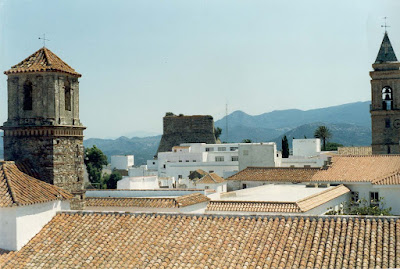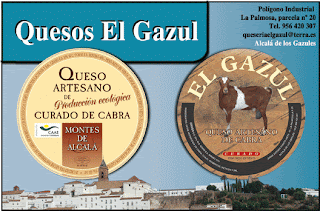 Las calles de Alcalá cobraban un protagonismo especial los días de lluvia. Eran frecuentes, aunque ignora el motivo, pero eran frecuentes. Ahora piensa que la serranía gaditana es generosa en aguas, porque allí van a desahogarse las negras nubes que vienen de Sanlúcar, de El Puerto, de Cádiz y de toda la fachada atlántica. Esas formidables bolsas de agua chocan con los altos picos de las sierra del Aljibe, entre las sierras del norte y las del sur de la provincia y descargan allí originando verdaderas trombas de agua. Los ríos Fraga, Álamo, Rocinejo, Patrite y Alberite reúnen las aguas de los arroyos, gargantas, regatos y “canutos” para engrosarlas en el río principal, el Barbate.
Las calles de Alcalá cobraban un protagonismo especial los días de lluvia. Eran frecuentes, aunque ignora el motivo, pero eran frecuentes. Ahora piensa que la serranía gaditana es generosa en aguas, porque allí van a desahogarse las negras nubes que vienen de Sanlúcar, de El Puerto, de Cádiz y de toda la fachada atlántica. Esas formidables bolsas de agua chocan con los altos picos de las sierra del Aljibe, entre las sierras del norte y las del sur de la provincia y descargan allí originando verdaderas trombas de agua. Los ríos Fraga, Álamo, Rocinejo, Patrite y Alberite reúnen las aguas de los arroyos, gargantas, regatos y “canutos” para engrosarlas en el río principal, el Barbate. 
Para aprovecharlas, las recogen los pantanos de la provincia. Por un lado, los de Zahara de la Sierra, de Bornos y de Arcos; por otro, el del Charco de los Hurones y del Guadalcacín o Majaceite, que es lo mismo. Alcalá queda en medio viendo bajar el agua a través de sus ríos al pantano de Benalup. La cúspide de la sierra es la “Pilita de la Reina”, de más de mil metros de altitud, de la que parten tres ramales: uno baja hacia el oeste formando la garganta de Puerto Oscuro y culminando en el Picacho del Aljibe (884 m.); otro acaba en el pico del Montero (912 m.) y el tercero se dirige al risco de la Gallina, pasando el Puerto Gáliz. Es el corazón de los Alcornocales.

Pero a lo que vamos. Las calles de Alcalá se convertían los días de lluvia en auténticos ríos y era una fiesta para los chavales. Las aguas bajaban desde la plaza Alta y acogían las que asomaban por todas las callejas, tejados y rincones. Al llegar a la Alameda y a la calle la Amiga, eran ya un torrente sin freno, en avalancha, que buscaba la cuesta de la Salá y el Barbate, y el Río Verde camino de la playa y de los otros ríos. Los chavales inventaban todo tipo de objetos navegables: cañas, maderos, tablas, barcos o cajas de cartón... para ver cuál cogía ventaja y bajaba con mayor rapidez. El agua llegaba dando saltos con furia por los escalones de las calles empedradas y arrastrando a su paso todo lo que podían. Muchas personas defendían con maderas y tablas las entradas de las casas, para que el agua no las inundara. De vez en cuando pasaban objetos que el agua arrebataba y no había quien los pudiera rescatar.

Cierto día de lluvia, estando asomado al portalón de su casa, Un chaval corría calle abajo con una botella para ir a lo de Vicenta a comprar aceite. Vicenta tenía la tiendecilla en la entrada de la calle Real. Vendía aceite, borra y queso “emborrao”. Al volver, el chaval venía metiéndose en el agua y jugando con los objetos que bajaban con la corriente. De pronto, se le resbaló la botella y se rompió al dar en la acera. El aceite salió haciendo circunferencias verdes y grasas sobre el agua y desapareciendo en un suspiro calle abajo. El chaval se levantó llorando, empapado en agua y sin atreverse a ir a su casa. Inmediatamente, él subió y se lo contó a sus padres. Su madre lo secó y lo puso cerca del anafe para que se calentara. Su padre cogió una botella y le dio dinero para que Vicenta se la llenara de aceite. Todos los hermanos miraban sorprendidos lo que estaban haciendo sus padres, pero ninguno se atrevía a decir nada.
Aquel gesto no lo olvidará nunca. Sus padres hacían estas cosas sin darles importancia, quizás con cierta intención pedagógica. En aquellos tiempos, la solidaridad era una obligación en los pueblos, porque la guerra había inundado de pobreza a la mayoría de las familias. La madre del niño se enteró de lo ocurrido y vino a agradecer lo que habían hecho con su hijo. También el agradecimiento contaba en aquellos años en los que todos se necesitaban. Son gestos que los padres deberíamos hacer con frecuencia, porque no hay mejor huella educativa que la actitud de los padres. Para terminar, quiero añadir que, este año, afortunadamente, ha sido un año de lluvias. Pero en Alcalá había también años de sequías sonadas. Otro día hablaremos de las sequías de Alcalá y de lo que hacían los alcalaínos para remediarlas.
JUAN LEIVA















 Coincidió con su antiguo maestro, Juan Coca Visglerio, en la puerta de la Farmacia de Galán y ahí queda esta foto para el recuerdo.
Coincidió con su antiguo maestro, Juan Coca Visglerio, en la puerta de la Farmacia de Galán y ahí queda esta foto para el recuerdo.






